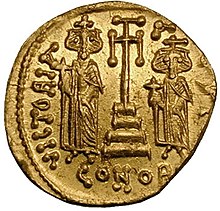Tiberius (son of Constans II)
| Tiberius | |||||
|---|---|---|---|---|---|
| Emperor of the Byzantine Empire | |||||

|
|||||
| Byzantine Emperor | |||||
| Reign | 659–681 (22 years) | ||||
| Coronation | 659 | ||||
| Predecessor | Constans II | ||||
| Successor | Constantine IV | ||||
| Co-emperors |
|
||||
| Born | Constantinople | ||||
|
|||||
| Dynasty | Heraclian | ||||
| Father | Constans II | ||||
| Mother | Fausta | ||||
| Religion | Christianity | ||||
| Full name | |
|---|---|
| Flavius Tiberius Augustus |
| Heraclian dynasty | |||
| Chronology | |||
| Heraclius | 610–641 | ||
| with Constantine III as co-emperor, 613–641 | |||
| Constantine III | 641 | ||
| with Heraklonas as co-emperor | |||
| Heraklonas | 641 | ||
| Constans II | 641–668 | ||
| with Constantine IV (654–668), Heraclius and Tiberius (659–668) as co-emperors | |||
| Constantine IV | 668–685 | ||
| with Heraclius and Tiberius (668–681), and Justinian II (681–685) as co-emperors | |||
| Justinian II | 685–695, 705–711 | ||
| with Tiberius as co-emperor, 706–711 | |||
| Succession | |||
|
Preceded by Justinian dynasty and Phocas |
Followed by Twenty Years' Anarchy |
||
Tiberius (Greek: Τιβέριος, Tiberios) was Byzantine co-emperor from 659 to 681. He was the focus of a military revolt and was eventually dethroned by his brother, the senior emperor Constantine IV.
Tiberius was the youngest son of Constans II. His mother was Fausta, daughter of the Patrician Valentinus. Although his eldest brother Constantine IV had been raised to the rank of co-emperor in 654, in 659, prior to his father’s departure for Italy, Tiberius was also elevated by Constans to the rank of co-emperor, alongside his older brother Heraclius. In 663, Constans tried to have his sons join him in Sicily, but this provoked a popular uprising in Constantinople, and the brothers remained in the imperial capital.
With Constans II’s death in 668, Constantine IV became the senior emperor. He attempted to demote his brothers from the imperial position, but this provoked a military revolt in the Anatolic Theme. The army marched to Chrysopolis, and sent a delegation across the straits of the Hellespont to Constantinople, demanding that the two brothers should remain co-emperors alongside Constantine IV. They based their demand on the belief that, since Heaven was ruled by the Trinity, in the same way the empire should be governed by three Emperors. Confronted by this situation, Constantine kept a close eye on his brothers, and sent across a trusted officer, Theodore, the captain of Koloneia, giving him the delicate task of praising the soldiers for their devotion and agreeing with their reasoning, with the objective of persuading them to return to their barracks in Anatolia. He also invited the leaders of the rebellion to come over to Constantinople and consult with the Senate in order that they may begin the process of confirming the army’s wishes. Happy with this apparently positive outcome, the army departed back into the interior of Anatolia, while the instigators of the movement entered the city. With the military threat now gone, Constantine moved against the leaders of the revolt, captured them and had them hanged at Sycae.
...
Wikipedia
